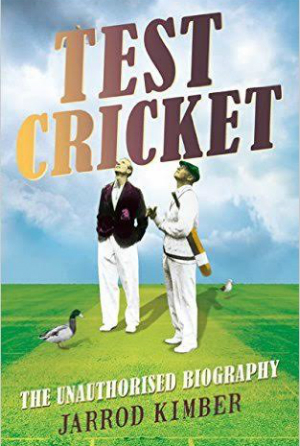 I love Test cricket. Perhaps not as much as I do my wife and children, but Test cricket has been in my life far longer. Like anything that you truly love, there are times when you ignore its imperfections, but in doing so you are failing to see the whole picture. Test cricket is like life and like society. It mirrors the mistakes that humans make, at times holding up those mistakes as being something to be proud of.
I love Test cricket. Perhaps not as much as I do my wife and children, but Test cricket has been in my life far longer. Like anything that you truly love, there are times when you ignore its imperfections, but in doing so you are failing to see the whole picture. Test cricket is like life and like society. It mirrors the mistakes that humans make, at times holding up those mistakes as being something to be proud of.
For us to really appreciate Test cricket for all that it is, we need to accept the times that it has got it wrong, and how it came about. It happened by accident, created in a haphazard fashion by people who were making it up as they went along.
It was at times sexist, racist and driven by greed. It was those things because the men that created it were those things. From South Africa’s policy to only select white players to the reluctance of some to pick K.S. Ranjitsinhji, to the treatment of the cricketers who played in the first women’s Test in 1934, cricket has been at the heart of injustice all too often. When we talk about the history of the sport it is important to remember that.
In his new book, Test Cricket: The Unauthorised Biography, Jarrod Kimber tells the warts and all story of how the game so many of us love developed. Like any good celebrity biography, it doesn’t leave out the gory bits that the subject would be embarrassed about. From the days of the wonderful bearded cheat that was WG Grace to the rise of the IPL, this is a rip-roaring ride through the history of cricket, a game that was first created because it was great for gambling.
Kimber does an amazing job at getting to the heart of the issue quickly but with enough detail that you walk away feeling informed. While this is a serious book with a serious story to tell, there are enough “Kimberisms” to make you smile.
Describing “The Demon” Fred Spofforth, Kimber turns on the style:
“At the crease he had a maniacal action that would summon up hellfire and unleash it on his enemies, turning from comic villain to bringer of the apocalypse. A giant mutant, half-man, half-octopus, standing well above you, limbs flailing in every direction, and the ball spitting out of him at a pace quicker than any human had bowled before.”
While us modern cricket fans have grown up with the Australians being the hard-nosed sledgers who would do anything to win, Kimber tells us of how, in the beginning, it was the English who were the bastards. From Grace replacing bails after being bowled and blaming it on the wind to Douglas Jardine and bodyline.
The Australian who was a hard-as-nails, win-at-all-costs player was Warwick Armstrong, Kimber describes him so well:
“Warwick Armstrong didn’t believe in walking. Warwick Armstong didn’t believe the laws should apply to him. Warwick Armstong would do anything to win. Warwick Armstrong was a proper bastard. Warwick Armstrong was Australian cricket as we now know it.”
Cricket’s development has so often been haphazard, and while there are many of us who bemoan the attitude of those that run the sport’s approach to growing the game, it has ever been thus. The insistence of the Imperial Cricket Conference, the forerunner of today’s ICC, that cricket was a game of the commonwealth meant that despite their being cricket of an excellent standard in the USA and Argentina, neither could become a Test nation. Stories that are well told in this book.
So often cricket is seen through the prism of the characters that play it, and Kimber’s book is no different. We are given vivid descriptions of players that we know so well, Bradman, Hobbs, Grace, and also details of ones that will be new to many. The Maharajah of Vizianagram, perhaps the worst captain India ever had, was new to me. And while Victor Trumper was a name that I knew, Kimber’s description of Bradman trying to understand Trumper being “like asking a calculator to understand a painting” was a highlight.
The description of the loss of South Africans like Mike Procter, Barry Richards and Graeme Pollock really strikes a chord. The story of Basil D’Oliveira is ably told. Kimber’s attitude toward the then South African Prime Minister, BJ Vorster, is summed up when he describes him addressing “a rally of fellow racists.” The loss of those precocious talents was a shame; chances are it was the right thing to do.
There is a fine description of the earthquake that shook Australian cricket, and cricket worldwide, thanks to Mr. Kerry Packer. Kimber writes, “While old men worked on the perfect blazer pocket, there was an enormous shadow looming over their self-congratulatory Centenary Test.” And that shadow was about how much cricket was worth. There are many parallels with the “Big 3” takeover in early 2014.
Test cricket’s tale is an unfinished one, with people prophesying its demise from the moment it was born. This book is as fine an attempt as any to put the whole story in one volume. You can buy it as an actual book in Australia and as an ebook everywhere else. I highly recommend you get hold of a book that is set to become a definitive work on the subject.
Test Cricket: The Unauthorised Biography by Jarrod Kimber is published by Hardie Grant Books. You can buy it here - http://www.amazon.co.uk/Test-Cricket-unauthorised-biography-Jarrod-Kimber/dp/1743790198